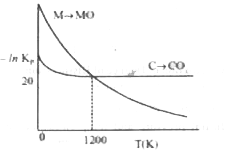The plot shows the variation of −InKp versus temperature for the two reactions.
M(s)+12O2(g)→MO(s)andC(s)+12O2(g)→CO(s)

Identify the correct statement :
A
At T<1200K, oxidation of carbon is unfavourable.
B
Oxidation of carbon is favourable at all temperatures.
C
At T>1200K, the reaction MO(s)+C(s)→M(s)+CO(g) is spontaneous.
D
At T>1200K, carbon will reduce MO(s) to M(s).
Text Solution
The correct Answer is:C

At T<1200K, carbon will reduce MO(s) to M(s) hence, chemical reaction
MO(s)+C(s)→M(s)+CO(g) is spontaneous.
|
Topper's Solved these Questions
- EQUILIBRIUMBOOK - DISHA PUBLICATIONCHAPTER - EQUILIBRIUMEXERCISE - Exercise-1: Concept Builder (Topicwise) (TOPIC 1: Law of Mass Action, Equilibrium Constant (Kc and Kp) and its Applications)
24 Videos
- EQUILIBRIUMBOOK - DISHA PUBLICATIONCHAPTER - EQUILIBRIUMEXERCISE - Exercise-1: Concept Builder (Topicwise) (TOPIC 2: Relation between K, Q, G and Factors Effecting Equilibrium)
9 Videos
- ENVIRONMENTAL CHEMISTRY BOOK - DISHA PUBLICATIONCHAPTER - ENVIRONMENTAL CHEMISTRY EXERCISE - Exercise -2 : Concept Applicator
15 Videos
- GENERAL PRINCIPLES AND PROCESSES OF ISOLATION OF ELEMENTSBOOK - DISHA PUBLICATIONCHAPTER - GENERAL PRINCIPLES AND PROCESSES OF ISOLATION OF ELEMENTSEXERCISE - EXERCISE -1: CONCEPT APPLICATOR
35 Videos
Similar Questions
Knowledge Check
Select the correct staement for the conversion of
MO(s)→M(g)+12O2(g)AEntropy increasesBIt is an endothermic changeCTo make ΔG∘ negative, temperature should be high enough so that TΔS∘>ΔH∘.Dall are correct statementsThe equation 2Al(s)+32O2(g)→Al2O3(s) shows that .
A2 moles of Al react with 32 moles of O2 to produce 72 moles of Al2O3B2 g of Al react with 32 g of O2 to produce one mole of Al2O3C2 g of Al react with 32 litre of O2 to produce 1 mole of Al2O3D2 mole of Al react with 32 moles of O2 to produce 1 mole of Al2O3Consider the following reactions:
C(s)+O2(g)→CO2(g)+x kJ
CO(g)+12O2(g)→CO2(g)+y kJ
The heat formation of CO(g) is :A−(x+y) kJ/molB(x-y) kJ/molC(y-x) kJ/ molDNone of these
Identify the oxidant and the reductant in the following reactions:
a. Zn(s)+12O2(g)→ZnO(s)
b. Zn(s)+2H⊕(aq)→Zn2+(aq)+H2(g)
View SolutionFor the reaction, Ag2O(s)→2Ag(s)+12O2(g) which one of the following is true?
View SolutionIn the reaction
aFe(s)+bH2O(g)→mFe3O4(s)+nH2(g)
a, b, m and n respectively are
View SolutionWhat is the equilibrium expression for the reaction P4(s)+5O2(g)⇔P4O10(s) ?
View SolutionWhat is the equilibrium expression for the reactionP4(s)+502(g)⇔P4O10(s)
View Solution
